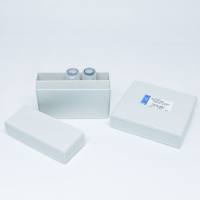Using the Auditory Brainstem Response (ABR) to Determine Sensitivity of Hearing in Mutant Mice
互联网
- Abstract
- Table of Contents
- Materials
- Figures
- Literature Cited
Abstract
Measurements of auditory evoked potentials can be used to determine reliably an audiometric representation of hearing sensitivity in mice. In a high?throughput phenotyping screen of mice carrying targeted mutations of single genes, the auditory brainstem response (ABR) is used to gain an estimate of hearing threshold for broadband click stimuli and pure tone frequencies ranging from 6 to 30 kHz. Comparison of thresholds obtained in mutant and wild?type mice give a means to determine mild, moderate, and severe hearing impairment. This gives a clear advantage over using a ?clickbox? test to assess hearing by observations of the Preyer reflex. The ABR screen has identified several mutant lines with mild and moderate hearing loss, which appear to demonstrate normal Preyer responses. The ABR technique also allows frequency?selective hearing loss to be identified. Curr. Protoc. Mouse Biol. 1:279?287 © 2011 by John Wiley & Sons, Inc.
Keywords: hearing; evoked potential; electrophysiology; high?throughput screening
Table of Contents
- Reagents and Solutions
- Commentary
- Literature Cited
- Figures
Materials
Basic Protocol 1:
Materials
|
Figures
-
Figure 1. Positioning of sub‐dermal electrodes for ABR recording. (A ) Electrode configuration, to demonstrate the hook introduced onto commercially available EEG electrodes. The three views, from left to right, indicate an oblique view, an end‐on view and a side view of the hook in the needle electrode. (B ) The positioning of the active electrode on the vertex of the mouse. (C ) The positioning of the reference and ground electrodes in the patch of bare skin behind the pinna overlying the bulla. View Image -
Figure 2. A schematic to illustrate the ABR setup used for high‐throughput screening with free‐field sound stimulation. The mouse is shown, with electrodes attached, on a heating blanket, with 20 cm between the leading edge of the loudspeaker and the mouse's interaural axis. For sound system calibration, the microphone is positioned where the center of the animal's head will be later positioned, oriented along the line of the interaural axis. Each TDT System3 module is housed within a zBus caddy. A gigabit (or optibit) interface provides communication between programmable modules and the computer system. View Image -
Figure 3. Click‐evoked ABR traces recorded from a control and Atp2b2Obv /+ mouse. ABRs were recorded in response to clicks at 5‐dB incremental sound levels from 10 to 85 dB SPL in wild‐type mice (A ) and from 10 to 95 dB SPL in mutant mice (B ). The estimated threshold ABR is plotted as a heavy trace and the threshold indicated adjacent. Four positive peaks are clearly indentified in control mice (indicated by P1, P2, P3, and P4). For this mutant, the ABR waveform was significantly altered (P1‐P3 were not present), as well as having a high threshold. View Image -
Figure 4. ABR audiograms for wild‐type and Atp2b2Obv /+ mice. ABR thresholds are plotted for individual wild‐type and mutant mice in the right and left panels, respectively. Mean ABR thresholds (± standard deviation, SD) are plotted for wild‐type (green) and Atp2b2Obv /+ mice (blue) for the range of frequencies tested and for clicks. In the center panel, mean thresholds (± SD) are re‐plotted for wild‐type (green) and Atp2b2Obv /+ mice (blue) over a reference mean threshold (±1 SD and 2 SDs and shown as lighter green and darker green areas, respectively) calculated from a large population of wild‐type mice on the same genetic background. View Image
Videos
Literature Cited
| Martin, G.K., Stagner, B.B., and Lonsbury‐Martin, B.L. 2006. Assessment of cochlear function in mice: Distortion product otoacoustic emissions. Curr. Protoc. Neurosci. 8.21C.1‐8.21C.18. | |
| Pauli‐Magnus, D., Hoch, G., Strenzke, N., Anderson, S., Jentsch, T.J., and Moser, T. 2007. Detection and differentiation of sensorineural hearing loss in mice using auditory‐steady state responses and transient auditory brainstem responses. Neuroscience 149:673–684. | |
| Spiden, S.L., Bortolozzi, M., Di Leva, F., Hrabe de Angelis, M., Fuchs, H., Lim, D., Ortolano, S., Ingham, N.J., Brini M., Carafoli, M., Mammano, F., and Steel, K.P. 2008. The novel mouse mutation Oblivion inactivates the PMCA2 pump and causes progressive hearing loss. PLoS Genetics 4:e1000238. | |
| Internet Resources | |
| http://www.sanger.ac.uk/mouseportal | |
| Web site for phenotyping and mutant mouse resources at the Wellcome Trust Sanger Institute. |









